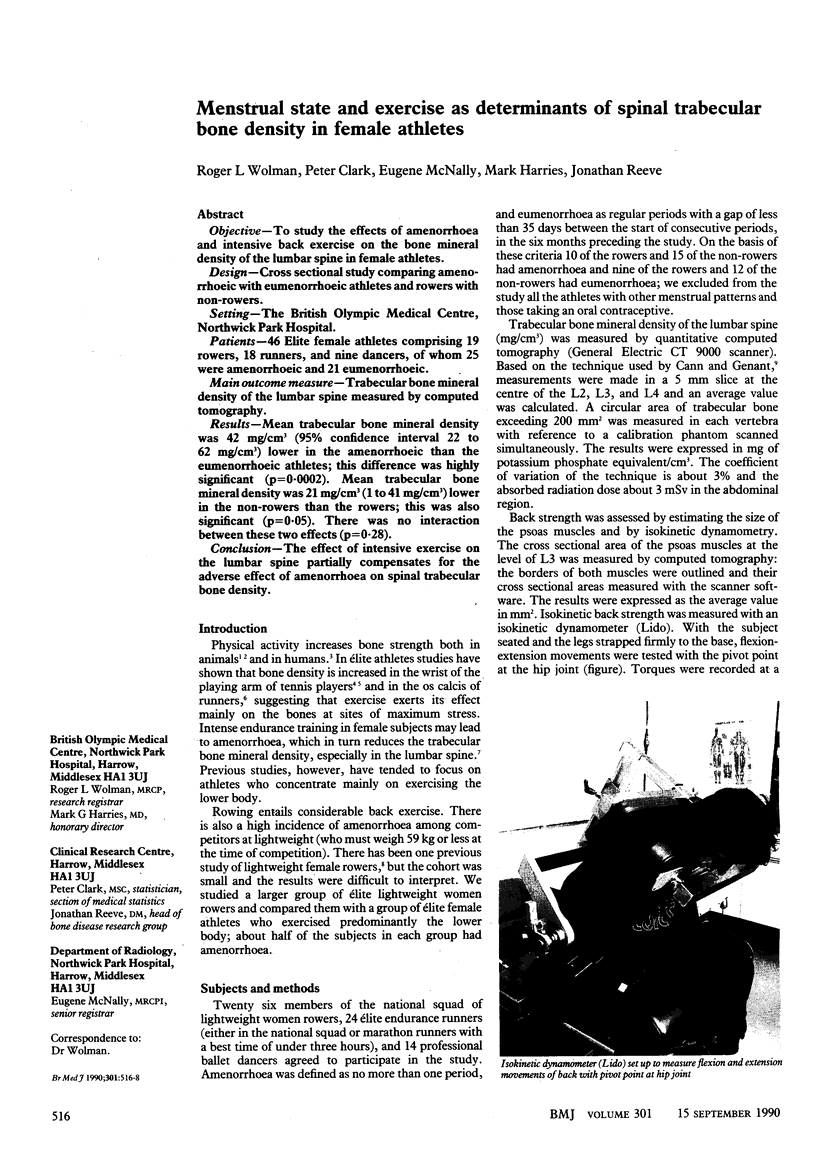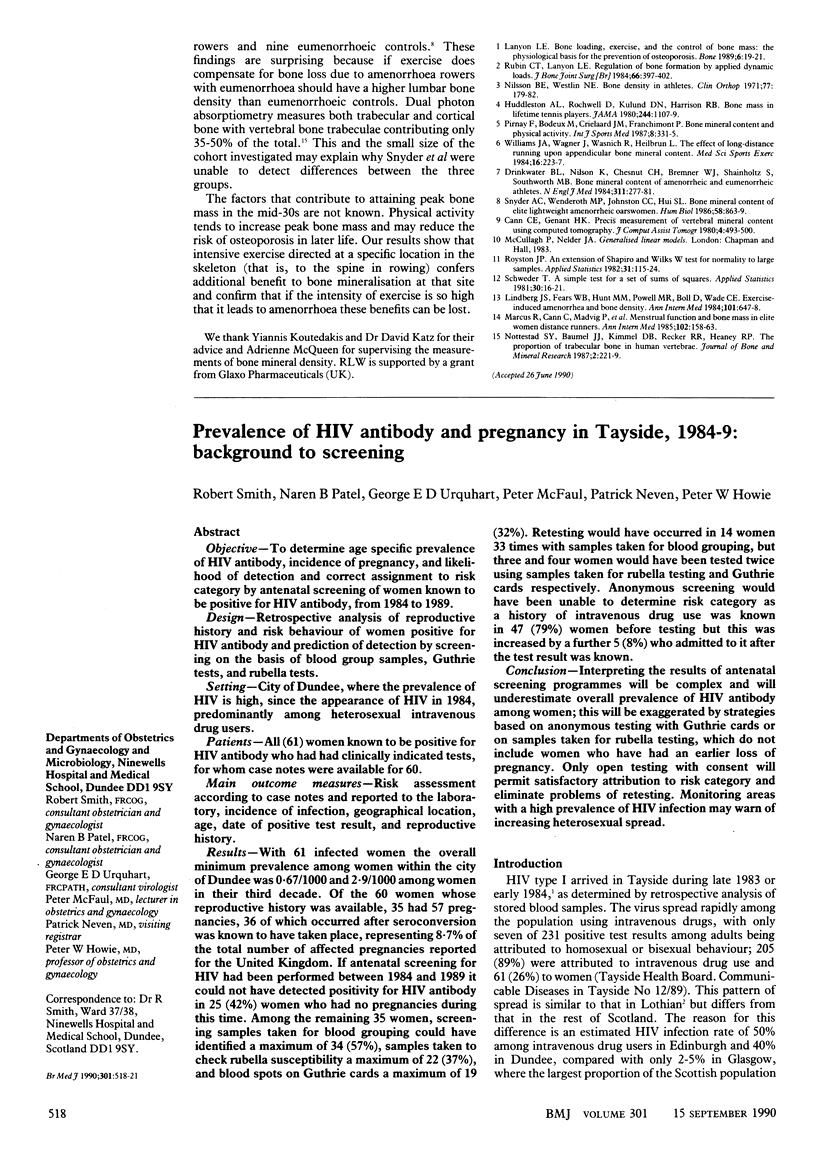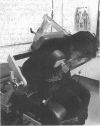Abstract
OBJECTIVE--To study the effects of amenorrhoea and intensive back exercise on the bone mineral density of the lumbar spine in female athletes. DESIGN--Cross sectional study comparing amenorrhoeic with eumenorrhoeic athletes and rowers with non-rowers. SETTING--The British Olympic Medical Centre, Northwick Park Hospital. PATIENTS--46 Elite female athletes comprising 19 rowers, 18 runners, and nine dancers, of whom 25 were amenorrhoeic and 21 eumenorrhoeic. MAIN OUTCOME MEASURE--Trabecular bone mineral density of the lumbar spine measured by computed tomography. RESULTS--Mean trabecular bone mineral density was 42 mg/cm3 (95% confidence interval 22 to 62 mg/cm3) lower in the amenorrhoeic than the eumenorrhoeic athletes; this difference was highly significant (p = 0.0002). Mean trabecular bone mineral density was 21 mg/cm3 (1 to 41 mg/cm3) lower in the non-rowers than the rowers; this was also significant (p = 0.05). There was no interaction between these two effects (p = 0.28). CONCLUSION--The effect of intensive exercise on the lumbar spine partially compensates for the adverse effect of amenorrhoea on spinal trabecular bone density.
Full text
PDF


Images in this article
Selected References
These references are in PubMed. This may not be the complete list of references from this article.
- Cann C. E., Genant H. K. Precise measurement of vertebral mineral content using computed tomography. J Comput Assist Tomogr. 1980 Aug;4(4):493–500. doi: 10.1097/00004728-198008000-00018. [DOI] [PubMed] [Google Scholar]
- Drinkwater B. L., Nilson K., Chesnut C. H., 3rd, Bremner W. J., Shainholtz S., Southworth M. B. Bone mineral content of amenorrheic and eumenorrheic athletes. N Engl J Med. 1984 Aug 2;311(5):277–281. doi: 10.1056/NEJM198408023110501. [DOI] [PubMed] [Google Scholar]
- Huddleston A. L., Rockwell D., Kulund D. N., Harrison R. B. Bone mass in lifetime tennis athletes. JAMA. 1980 Sep 5;244(10):1107–1109. [PubMed] [Google Scholar]
- Lindberg J. S., Fears W. B., Hunt M. M., Powell M. R., Boll D., Wade C. E. Exercise-induced amenorrhea and bone density. Ann Intern Med. 1984 Nov;101(5):647–648. doi: 10.7326/0003-4819-101-5-647. [DOI] [PubMed] [Google Scholar]
- Marcus R., Cann C., Madvig P., Minkoff J., Goddard M., Bayer M., Martin M., Gaudiani L., Haskell W., Genant H. Menstrual function and bone mass in elite women distance runners. Endocrine and metabolic features. Ann Intern Med. 1985 Feb;102(2):158–163. doi: 10.7326/0003-4819-102-2-158. [DOI] [PubMed] [Google Scholar]
- Nilsson B. E., Westlin N. E. Bone density in athletes. Clin Orthop Relat Res. 1971;77:179–182. [PubMed] [Google Scholar]
- Nottestad S. Y., Baumel J. J., Kimmel D. B., Recker R. R., Heaney R. P. The proportion of trabecular bone in human vertebrae. J Bone Miner Res. 1987 Jun;2(3):221–229. doi: 10.1002/jbmr.5650020309. [DOI] [PubMed] [Google Scholar]
- Pirnay F., Bodeux M., Crielaard J. M., Franchimont P. Bone mineral content and physical activity. Int J Sports Med. 1987 Oct;8(5):331–335. doi: 10.1055/s-2008-1025679. [DOI] [PubMed] [Google Scholar]
- Rubin C. T., Lanyon L. E. Regulation of bone formation by applied dynamic loads. J Bone Joint Surg Am. 1984 Mar;66(3):397–402. [PubMed] [Google Scholar]
- Snyder A. C., Wenderoth M. P., Johnston C. C., Jr, Hui S. L. Bone mineral content of elite lightweight amenorrheic oarswomen. Hum Biol. 1986 Dec;58(6):863–869. [PubMed] [Google Scholar]
- Williams J. A., Wagner J., Wasnich R., Heilbrun L. The effect of long-distance running upon appendicular bone mineral content. Med Sci Sports Exerc. 1984 Jun;16(3):223–227. [PubMed] [Google Scholar]



